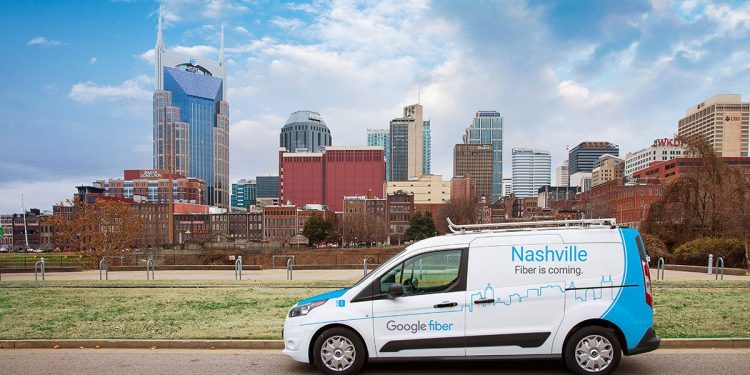Google Fiber, the division of Google parent company Alphabet that provides fiber-to-the-premises service in the U.S., will no longer sell 100Mbps broadband plans to new customers. This morning, Fiber announced that it’ll only offer gigabit (1,000Mbps) plans going forward in all 18 regions where it has launched to date.
The gigabit plan’s pricing — $70 per month — won’t change, nor will its terms. (There’s no data cap or throttle to speak of.) Starting tomorrow, Fiber will roll out a partnership with YouTube that’ll let customers sign up for YouTube TV at the same time they sign up for Google Fiber. And current customers on the 100Mbps tier were notified today that beginning February 2020, they’ll receive an increase in upload and download speeds from 100 to 500Mbps for an additional $5 per month.
Google Fiber acknowledges in a blog post that it’s a somewhat self-serving transition. After all, faster speeds benefit Alphabet and sister company Google’s countless ventures, among them YouTube and cloud gaming service Stadia. Both Stadia and YouTube support up to 4K HDR videos at 60 frames per second, which requires a minimum of 35Mbps for smooth playback. As for Stadia, Google anticipates it’ll begin serving data-hungrier 8K streams at 120 frames per second in the near future.
Fiber also notes that internet usage continues to expand globally. Cisco projects that traffic will grow 3.2-fold from 2016 to 2021, at a compound annual growth rate of 26%, and that so-called “busy hour” traffic will grow 4.6-fold over the same period.
June 5th: The AI Audit in NYC
Join us next week in NYC to engage with top executive leaders, delving into strategies for auditing AI models to ensure fairness, optimal performance, and ethical compliance across diverse organizations. Secure your attendance for this exclusive invite-only event.
“Seven years [after Fiber launched], we’ve seen a huge shift, not only in Internet speeds, but also in how we use the internet,” wrote Fiber. “With increasingly connected homes and ever-improving technologies, speed is more important than any time in our history — and becoming more important every day. [With] our fiber networks, we’re uniquely positioned to deliver it.”
Google Fiber was first introduced to the Kansas City metropolitan area in 2011, including 20 area suburbs within the first three years. It later expanded to Austin, Texas and Provo, Utah in April 2013, and subsequently to Atlanta, Charlotte, the Triangle, Nashville, Salt Lake City, and San Antonio in 2014 and 2015. And in 2016, Fiber acquired San Francisco-based Webpass to expand its reach in apartment and condo buildings with up-to-gigabit point-to-point wireless internet.
In mid-2016, Google Fiber had 68,715 television subscribers and was estimated to have about 453,000 broadband customers, but the company was forced to scale back its ambitions following internal tumult. In October 2016, on the heels of the departure of CEO Craig Barratt, Fiber cut its staff by 8% and paused fiber plans in 11 cities. Most recently, it was forced to switch off its network in Louisville, Kentucky and exit the city after fiber installation failures left cables exposed in the roads.
Google Fiber’s 100Mbps plan — Fiber 100 Internet — started at $50 per month and didn’t offer complimentary Google Drive storage, unlike the pricier gigabit plan. Additionally, it couldn’t be bundled with Fiber’s TV plan (but could be bundled with Fiber’s $10-per-month Fiber Phone plan) and didn’t come with the hardware included in upmarket plans, namely a TV box and an eight-tuner DVR.
Fiber currently provides free internet connectivity up to 5Mbps in each of its markets to select affordable housing properties, through its Gigabit Communities program. A spokesperson tells VentureBeat that this won’t change.

